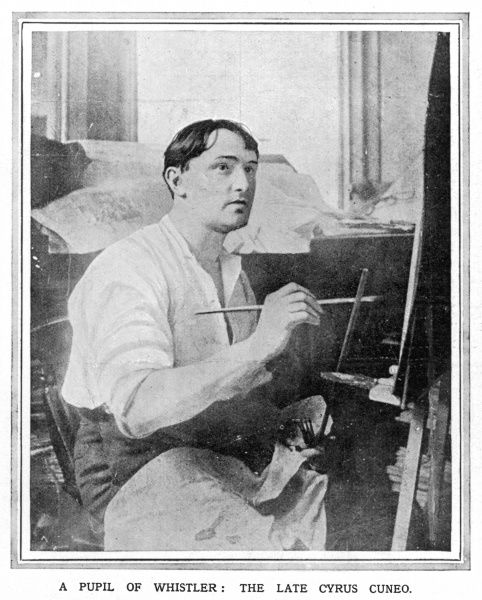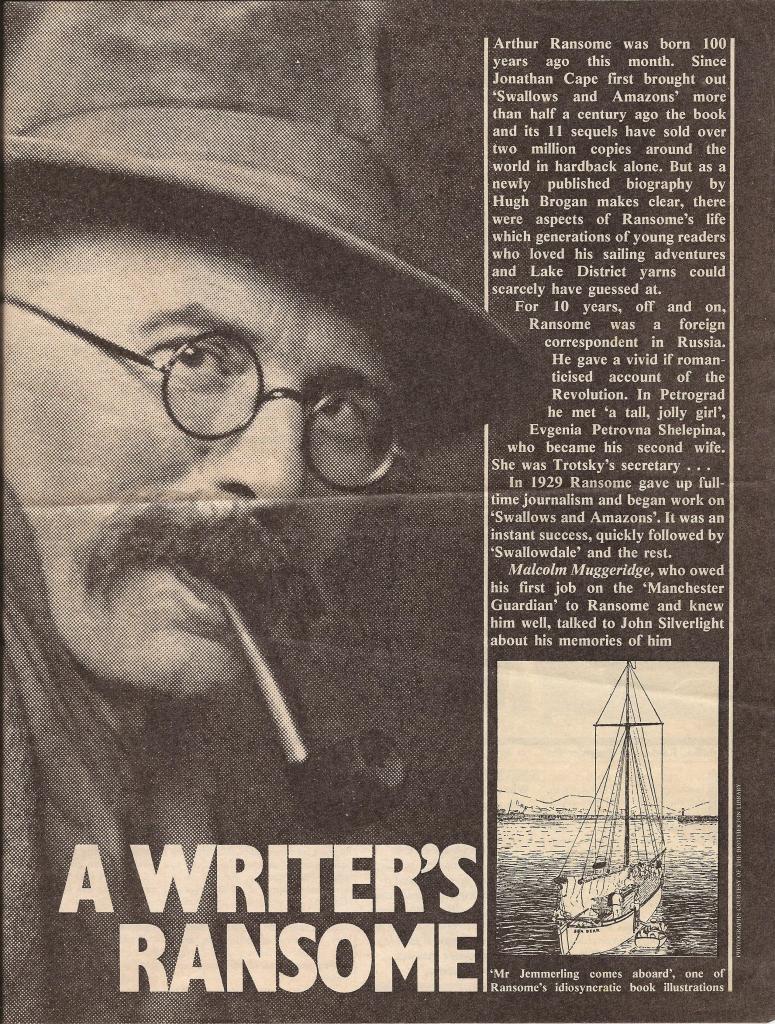Arthur Ransome and the painter Cyrus Cuneo were both members of the Langham Sketching Club in London. An unsigned portrait of a balding, moustached gentleman, has come to light that is believed to be a sketch of Ransome dated between 1912 and 1914. He is wearing a round glasses, a stiff white collar and sandy-coloured jacket, painting at a desk in front of dark bookcases. You can just see a hint of the pipe in his mouth.
In 2021, Rosebery’s Auctions in London listed this 45.5cm x 30cm oil-on-board painting in their catalogue as ‘a portrait of the artist’ Cyrus Cuneo, but he was dark, clean-shaven and heavy shouldered, having been a professional boxer, as depicted below. When this was pointed out, Rosebery’s replied that it was, ‘just a self-portrait of an artist at the Langham.’ The setting is backed up by a label on the reverse, but the painting is unsigned.
The painting is similar to the portrait Dora Altounyan painted of Arthur Ransome in early 1932, which was bequeathed by Evgenia Ransome to Abbot Hall museum in Kendal, now curated by Lakeland Arts. He is wearing exactly the same kind of jacket, but has hair the same colour, with a shorter haircut.

In photographs taken before the First World War, Ransome’s hair looks fuller and darker but could, presumably, have been lathered with pomade. He is wearing the pince-nez glasses and holding the same design of pipe in the photo used on the cover of Hugh Brogan’s The Life of Arthur Ransome taken in 1907 when he was twenty-five and kept by his daughter, Tabitha.
He had lost a lot of hair by the time he was photographed skipping down a lane with Tabitha, in 1917 as can be seen in this and another archive shot kept at the Brotherton Library in Leeds.
The Langham Sketching Club was set up at a stable yard in Gray’s Inn Lane in 1823 as ‘there was a need for a society where professional men could develop life drawing, improve work standards and meet in the company of like-minded artists’. It moved to 1 Langham Chambers, All Souls Place, London WI in 1938 and was henceforth known as The Langham, not to be confused with the Langham hotel.

Artists met for two hours every Friday evening in the winter to sketch, take dinner and chat. Members still gather today, bringing food for a candlelit dinner. Ladies were not incorporated until 2018 but there are now as many women as men. They meet on Wednesday evenings in The Upper Hall at St Columba’s in Pont Street.

Cyrus Cuneo, who studied art in Paris under Whistler, joined ‘The Langham’, as it is known, about 1903 and became Chairman in 1908. His son, the artist Terence Cuneo, was born in 1907. Cyrus sadly died of blood poisoning in 1916 after getting scratched by a hat pin at a dance, but his wife and biographer, Nellie Cuneo described ‘some gay, mad times’. Fellow members included the equine artist Alfred Munnings and Arthur Ransome. A reference in early 1914 states: ‘About this time Cyrus gave up doing the two hour sketches at the Langham Sketch Club, and started doing portraits of the members at work. Afterwards some of these were sold to sitters, who included Arthur Ransome.’

How well does this painting compare with a photographic portrait dated 1932? The eyebrows look right.
In Bohemia in London, published in 1907, Arthur Ransome writes: ‘Another famous artists’ club is the Langham Sketch Club, whose rooms are close behind the Queen’s Hall. Artists meet there regularly, and draw and make pictures all in a room together, with a time limit set for the performance. At intervals they exhibit the harvest of their evenings on the walls. They also have merry parties, for men only, when the doors are opened by fantastical figures, and scratch entertainments go on all the time, and there are songs and jovial recitations. Nights are as merry as any, and the rooms are full of celebrated men, and men about to be celebrated; for the club does not tolerate bunglers.’ (In the Studios p.81)

The artist Steven Spurrier, who drew the iconic map of Ransome’s ‘Great Lake in the North’ used on the dust jacket of the first editions of Swallows and Amazons, joined the club in 1906. He sketched groups sitting at different levels, on an assortment of furniture, as they drew. Some are balding and mustached, pipe smoking gentlemen, sketching under electric light. Most are wearing a jacket with a collar and tie. One could almost be Ransome.
Steven Spurrier RA, RBA,ROI (1878-1961) worked in charcoal or ink and wash, capturing the informal atmosphere. Did Ransome ever meet him at the club? He so loathed his illustrations commissioned by Jonathan Cape that, apart from the map, they were never used. Clifford Webb took on the challenge before Ransome produced his own line drawings and maps for Peter Duck, as if they had been drawn by his characters.
Nellie Tenison Cuneo illustrated a large number of books including The Girl Crusoes: A Story of the South Seas by Mrs Herbert Strang. Take one look at her paintings of girls with boats inside and you can imagine the impact they would have on Titty’s character.
Carole Cuneo, President of the Cuneo Society, recognised the portrait. ‘Yes, definitely by Cyrus, from the Langham Sketch Club, and definitely of Arthur Ransome.’ Although, as quoted above, her grandmother claimed, ‘some of these (portraits) were sold to sitters, who included Arthur Ransome’ one can only presume that he did not buy this one. Could there be another?
Carole first knew this picture in the 1950’s. It hung on the wall of her father, Terence Cuneo’s studio at Ember Lane in East Molesey, London, until after his death in 1996, when she inherited it. Carole clearly remembers Terence saying it was a portrait of Arthur Ransome. She had sold it, with other paintings to Sim Fine Art in about 2011, when it was sold again before turning up at Rosebery’s auction. It was purchased for £480, just under the estimated price, by the editor of the Cuneo Society Journal. Carole has provided him with a written statement to record the painting’s provenance for the future. He contacted me to find out about other portraits of Ransome and I was able to see the framed painting at his house in 2021. This shows an open box of paints and a vessel that could have held water. Magnus Smith of The Arthur Ransome Society points out that whilst Arthur Ransome’s pencil sketches and pen and ink drawings are well known, did he ever use paints?
Cyrus Cuneo, who exhibited at the Royal Academy, Royal Institute of Oil Painters and Glasgow Institute of Fine Art, was a distinguished illustrator and figurist, originating from America. If this is a hither-to unknown portrait of Arthur Ransome, it is an important discovery that will be of interest to the Arthur Ransome Trust, Lakeland Arts and members of The Arthur Ransome Society worldwide.
Ref: ‘Cyrus’ Ransome’ by David Bennett, Cuneo Society Journal Vol 5 Number 2
You can read more about Cyrus Cuneo here and about the history of the Langham Sketching Club here.
Terence Cueno’s art studio can bee seen in this film but I couldn’t spot the portrait of Ransome.
First published in Mixed Moss 2022, the Journal of The Arthur Ransome Society








A fascinating post Sophie, thank you. And the film of Terence Cuneo is brilliant, really interesting. Thank you so much for sharing this with us.
I wrote it for Mixed Moss, the journal if The Arthur Ransome Society but wanted to share a few more photos and the little film online. So glad you’ve enjoyed the article. It took days to write!
Well I am glad you did take the trouble to write it as I have enjoyed reading it, very much. I well remember, when seeing a painting by Terence Cuneo, looking for the mouse!
Hi Sophie even at 72 it’s my go to movie to cheer me up x
Sent from Outlook for Androidhttps://aka.ms/AAb9ysg ________________________________
I’m so glad you enjoy it! Thanks for taking the time to leave a comment. Do let me have any questions.
Hi Sophie I have found a book Swallowdale have you read it?Regards Roy
Sent from Outlook for Androidhttps://aka.ms/AAb9ysg ________________________________
Ahoy Roy! – I read Swallowdale as a child and recently when I was asked to write a Foreword by Albatros Media in the Czech Republic. You can read it here: https://sophieneville.net/2016/01/22/sophie-nevilleova/
Dear Sophie lovely foreword by you in Swallowdale .Some say Swallowdale is a better story than Swallows and Amazon’s? Regards Roy
Dear Sophie very nice foreword in Swallowdale some say it’s a more interesting story than Swallows and Amazon’s?Regards Roy
Sent from Outlook for Androidhttps://aka.ms/AAb9ysg ________________________________
There are some great one-liners in Swallowdale.